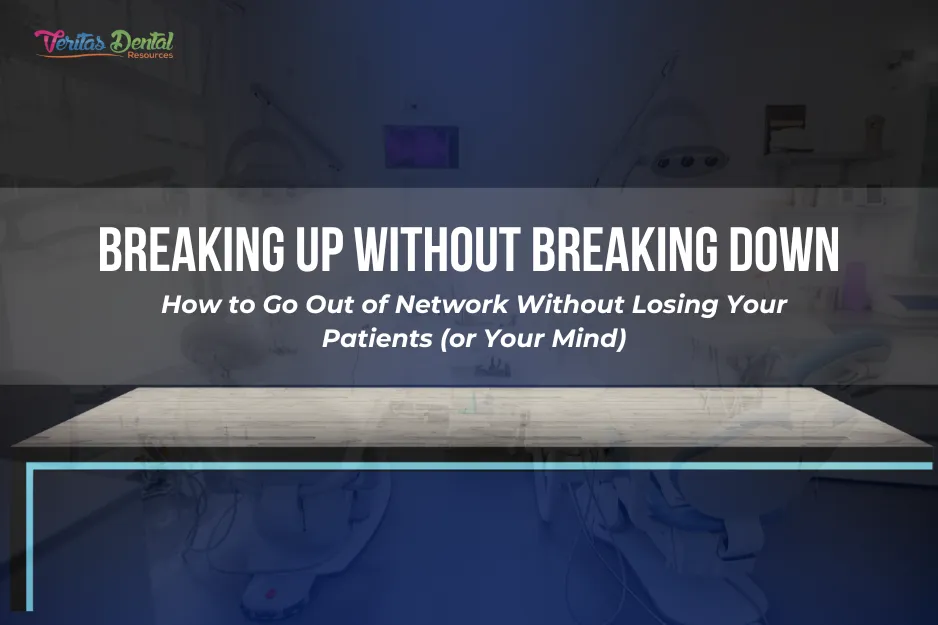
Breaking Up Without Breaking Down: How to Go Out of Network Without Losing Your Patients (or Your Mind)
There comes a time in every dentist’s life when you look at your PPO contracts and think: “It’s not me, it’s you.” And you’re right. Between declining reimbursements, increased denials, and the constant feeling that someone in a corporate office is micromanaging your clinical decisions without ever having stepped foot in your operatory—it’s no wonder more dentists are stepping away from in-network status.
But what scares dentists the most about going out of network?
Not the insurance paperwork. Not even the financial uncertainty.
It’s losing their patients.
Fortunately, you don’t have to. You just need a strategy—and the right words.
Act I: Why You’re Going Out of Network in the First Place
Let’s get one thing straight: you're not doing this to be difficult. You’re doing it because insurance interference has gotten so bad, it’s putting the quality of patient care at risk.
When in-network contracts come with strings attached—strings that pull down your fees, downgrade necessary treatment, and create patient confusion—it’s time to cut them loose.
And when you explain it that way, patients get it.
🧠 Pro Tip: Reframe "out of network" as "unrestricted" or "non-restricted." This subtle language shift changes the conversation from losing a benefit to gaining better care.
Act II: What To Say to Existing Patients (and When)
Timing is everything. Ideally, you should start preparing patients 4–6 months before submitting your termination letter to the insurance company. Yes, months. Early communication dramatically improves patient retention and trust.
🗣 The “Soft Launch” Conversation:
“I wanted to give you a heads-up that we’re considering a change with your dental insurance plan. Due to the heavy restrictions in our in-network agreement, we feel those restrictions are threatening the quality of care we can provide. We haven’t made any final decisions yet, but we want you to know we’re exploring a shift to a non-restricted status. If we move forward, we’ll keep you informed every step of the way.”
This shows patients that you:
Are being transparent
Are prioritizing their health
Aren’t making rash decisions
🗣 What to Emphasize in the Office:
“You will still have access to your benefits.”
“We’ll continue to handle all the insurance paperwork for you.”
“Our goal is to maintain the relationship you’ve trusted for years.”
“Unrestricted status means we get to focus solely on your care—not on what insurance allows.”
Let patients know this is about them, not you.
Act III: How to Talk to New Patients
You know the call:
“Hi, do you take MetLife?”
Cue dramatic music.
Here’s the script that works:
“Thanks for calling! While we’re not a participating provider with MetLife, we do have a large number of MetLife patients who come here and love the care they receive. We’re happy to help you use your benefits here, and we’ll handle the paperwork for you. Would mornings or afternoons work better for your first visit?”
If they push back:
“Is your plan a PPO, HMO, or discount plan?”
If it’s PPO:
“Great news—PPOs usually allow you to see any licensed provider. Being non-restricted allows us to give you the best care possible without insurance interference.”
If they say it’s “too expensive”:
“Totally understand—thank you for sharing that. Everyone deserves great care at a fair value. Quality can sometimes come with a cost, but if having a trusted team that prioritizes your health is important to you, we’d love to be your dental home.”
Then stop talking.
Let the silence do the work. Most patients will reflect and choose quality over network status.
Act IV: How to Know When It’s Safe to Drop a Plan
Before you send that termination letter, do your homework.
✅ Run a patient breakdown report
How many active patients are on the plan?
What procedures are most common among them?
✅ Review out-of-network benefits
Some plans—like Delta Premier in Ohio—still offer strong out-of-network benefits. Others, like HMOs or DHMOs, won’t pay a dime unless you're in-network.
✅ Check EOB and payment patterns
Do you regularly receive denials, downgraded benefits, or reimbursement issues with this plan? That’s a red flag.
✅ Talk to your team
Is your front office ready to handle tougher insurance conversations? Are you set up to collect patient portions at the time of service?
✅ Review ADA and legal compliance
Don't discount co-payments just to keep patients—especially without legal guidance. The ADA makes it clear: those discounts must be disclosed to the insurance plan and can open a can of worms.
Act V: The Power of Patient Letters and Scripts
A week before you officially submit your termination letter to the insurance company, send a letter to patients.
Why? Because patients value inclusion. When you tell them before it becomes an issue, they feel respected—and far more likely to stay.
Include in your letter:
Why the change is happening (hint: it’s about protecting care quality)
Reassurance that they can still use their benefits
Instructions on what to expect
Contact info for questions
Final Thoughts: Drop the Insurance, Not the Patient
Going out of network isn’t about burning bridges. It’s about building a better one—with your patients, with your team, and with your own peace of mind.
If you follow these best practices:
Start early
Communicate clearly
Train your team
Reframe the language
Own your value
…you won’t just survive going out of network.
You’ll thrive.
Because when you stop letting insurance dictate the rules, you regain control of the game.
🧾 Quick Recap (Print This for the Breakroom):
Use “non-restricted” instead of “out-of-network”
Give 4–6 months’ notice
Talk benefits, not contracts
Focus on care quality, not finances
Send patient letters before termination
Train your team with proven scripts
Don’t discount without legal guidance
Run the numbers before dropping any plan
Benjamin Tuinei
Founder - Veritas Dental Resources, LLC
Phone: 888-808-4513
Services:
PPO Fee Negotiators | PPO Fee Negotiating | Insurance Fee Negotiating
Insurance Credentialing | Insurance Verifications
Websites:
www.VeritasDentalResources.com | www.VerusDental.com

